Kimberley, South Africa
Kimberley Ex-Pats- Newsletter No 29


Kimberley Jewry and its religious provision 1873 – 2020
Compiled by Geraldine Auerbach, MBE, London, May 2020
With thanks to: Cyril Haberfeld’s booklet on the history of the community on the occasion of its centenary https://kehilalinks.jewishgen.org/kimberley/Community_files/Haberfeld%201.pdf in 1973 and Barney Horwitz, the present Chairman of the Community who has provided information from 1973 to now. Also thanks to Louis Herrman’s, A History of The Jews in South Africa, Brian Robert’s books on Kimberley, and information from Leon Chonin, June Haberfeld and others.
Two distinct communities
Until I started research for this Jewish Community website, I had no idea that Kimberley had had two distinct communities. I knew there were two shuls – the old little one and the new big one. How wrong I was! In fact, the small shul in Baronial Street was the newer one started in 1911 – while the big shul in Memorial Road had been consecrated in 1902. So how did this all come about?
I have pieced together as much as I can of the shuls and their ministers. Some I have no information at all about and for most only scant. But it gives a picture that should be recorded here.
Did you know there was ever a shul choir? And that Mendel Apter and Harry Klein were in it? See the picture in the 1930s with Cantor A Rudy. If you have any information anecdotes and snippets to add to any of this – I will be pleased to hear from you.
Kimberley has had two distinct communities with different shuls.
Interior of the Memorial Road Synagogue opened in September 1902


The first community was from Western Europe mainly Germany and Britain. Scarcely had the digging and sifting of diamondiferous ground began, when Jews descended on the diamond fields from 1867 onwards. By 1871 they had created an informal ‘association’ and in 1873 formed the Griqualand West Hebrew Congregation which built its first shul in 1876. This was unimposing and inadequate. As the community got stronger and richer, they opened the magnificent new Memorial Road Synagogue (above) in 1902. https://kehilalinks.jewishgen.org/kimberley/Synagogues.html

Gradually the two communities integrated. In the 40s to 60s The Grinne Shul (left in its latter days when it was no longer in use and looking the worse for wear) was used for the congregation’s weekday services and the ‘big’ synagogue was used for the Sabbaths and Holidays. In the 1980s and ‘90s the building was sold and became a storeroom for a Jewish business. Subsequently it was demolished.
In the 1870s and 1880s
In the 1870s and 1880s Jews were already well represented in the digger community and nearly half the brokers and buyers were Jews. There were also Jews who ran transport to the fields and who traded goods and services. They also took a prominent role in the social life of the diggings and emerging city. They featured significantly in boxing, racing, theatre, and other entertainments as well as in journalism.
It followed that they met and formed a congregation for divine service, praying in homes which were no more than tents. As early as 1871 a tentative congregation was set up, called the Griqualand West Jewish Association. Among its members were (later to become millionaires) Isaac Lewis, Woolf Joel and Lionel Phillips.
A corrugated iron building in Woodley Street was hired and filled to overflowing with worshippers
for the High Holydays.This was on the initiative of Joel Myers (a pioneer of the domestication of ostriches in Oudtshoorn) supported by Rev Joel Rabinowitz, the Minister in Cape Town (pictured below) who sent up festival prayer books and a Shofar as a gift from the mother community.
There was no regular minister and Kimberley Jews had to rely on the infrequent visits of Rabbis from Cape Town and Port Elizabeth for circumcisions and marriages. High Holydays services were conducted by lay members. It is on record that there was an unscrupulous self-styled ‘rabbi’ engaged in these early times, who had to be dismissed – and who revenged himself by sitting at the door of his tin habitation near the synagogue publicly desecrating the Day of Atonement by eating forbidden food in sight of the congregation.
1873The first permanent congregation
The Griqualand West Hebrew Congregation was formally established, with services continuing to take place in the hired hall in Woodley Street. Even then they had no full-time minister. When Rev Samuel Rappaport from Port Elizabeth visited in 1874 the Diamond News felt obliged to comment. ‘We are astonished,‘ it exclaimed, ‘that considering the number of Jewish residents in our midst, that they have not a regularly ordained minister, and a properly constructed place of worship’. Clearly those who had come to Kimberley had other priorities! However, plans were, already in place for building a synagogue and appointing a minister.
The First Synagogue Building 1876

In 1875 work began on the first synagogue building. The site was in Dutoitspan Road roughly where Cecil John Rhodes statue now stands. (See the picture left of the statue’s unveiling in 1907 – the synagogue is no longer there). The site had been given by the London and South African Exploration Company a syndicate of the old Hopetown Company headed by Henry Webb, Edgar Hurley and Jews, Louis Hond, and the Lillienfeld bothers. The company was a major owner of Diamondiferous property in Kimberley including the Bultfontein and Dutoitspan Mines, later taken over by De Beers Consolidated Mines in the amalgamation of all the mines by 1888. (See my story of Alfred Beit, on the website under pioneers for the exciting story of the amalgamation. https://kehilalinks.jewishgen.org/kimberley/Alfred_Beit.html
The Cornerstone for this first synagogue was laid with all due ceremony on 23 August 1875 by Mrs C Sonnenberg, wife of the first president of the congregation. The event was attended by many Christian friends amongst them civic dignitaries such as Sir Henry Barkly (Governor of the Cape Colony) and Sir Richard Southey (Administrator of the Diamond Fields).
The building, like all buildings in the town was a simple wood and corrugated iron structure designed to hold 250 people. When it was consecrated on 17 September 1876, it was already too small. (There were about 1400 Jewish souls in Kimberley by then, 600 of them adult males.)
The First Minister
1875 – 1878 Rev Berthold Albu was installed as the first spiritual leader of the Griqualand West Hebrew Congregation in the run-up to the opening of the first purpose-built synagogue. He served for the next three years and was the minister who consecrated the first synagogue in 1876. (He was probably related to the South African mining magnates Sir George and Leopold Albu. Margaret Albu, grand-daughter of Reverend Albu, was a concert pianist. In 1931 she married John Logie Baird, inventor and developer of the world's first television system.)
1878 – 1884Rev Meyer Mendelssohn was chosen by the then Chief Rabbi of Great Britain, Dr Adler, to replace Rev Albu in Kimberley. He made a terrific impact on the community. Born in 1833, he was distantly related to the composer and his famous grandfather the philosopher Moses Mendelssohn. He arrived in Britain from Germany in 1850 at the age of 17.

1884. Rev Joel Rabinowitz (left) came to minister in Kimberley for a time after he had retired from service in Cape Town and had returned from a visit to England. Rev Rabinowitz had served the Cape Town community from 1859 – 1882. He was the first properly ordained head of the Jewish Community in South Africa. When he arrived in South Africa, he ministered not only to the small Cape Town community, but travelled around the colony providing occasional services wherever required and got to know the hinterland and its Jews.
1884 – 1885 Rev Abraham Ornstein. (nephew of the Cape Town minister AF Ornstein) A young man of 21 Rev Ornstein, in the words of historian George Beet, ‘literally worked himself to death’. Described by Dr Matthews (also a non-Jew) as ‘a young man of infinite charm and capability’, He was full of enthusiasm and threw himself into his duties with great zeal and conscientiousness. He died a year after his appointment in June 1885 at the tender age of 22. Reference to the marriage register of the day reveals the rather poignant fact that he was married to a young girl of 18, named Bessie Cohen only six months prior to his death. The marriage ceremony had been performed by his uncle, the Rev AF Ornstein of Cape Town. He had so endeared himself to his congregants and other sections of the town that he was given a public funeral and the magnificent tombstone which adorns his grave was erected by public subscription by members of all denominations. Rev Mendelssohn (see above) stepped in again to fill the breech
1886-1888Rev Mark L Harris served for 2 years until his departure for Johannesburg. In January 1888, the newly formed Witwatersrand Hebrew Congregation purchased two plots of land on President Street to build a synagogue. On November 7 of that year, the Rev. Mark L. Harris of Kimberley laid the cornerstone and the work on Johannesburg's first synagogue officially began.
1888-1889Rev E Joffe served for a while
1890-1927 Rev Harris Isaacs was the ‘doyen of Kimberley ministers. He served for 33 years over a period of 37 years. – or did he? See later). He arrived from London in 1890. After serving for three years he left for Johannesburg in 1893. Returning to Kimberley in 1897, he attended to the needs and wants of the community with unflagging zeal and devotion for the next 20 years until his retirement in 1927. Recently, however, I have become aware that there was a ‘Formal leave taking of Reverend Harris Isaacs by the Jewish community’, on April 17th1912 – which was reported in the DFA. I am trying to find out a bit more about this event which is contrary to the community history as reported by Cyril Harris. (Of course, we know that the early records were lost when the old minute books etc were given to the war effort!) We will have to wait till after lockdown for the pandemic of coronavirus to know more about this (writing in May 2020).
Harris Isaacs was a great scholar and brilliant orator. He took an active interest in civic as well as Jewish affairs. He had a deep interest in education and collected funds for establishing the Stockdale Street School and was for many years the Vice Chair of the Kimberley School Board. He was mentioned in dispatches for his services to the town during the Siege of Kimberley 1899-1900.
The ‘New’ Synagogue Memorial Road

1901 – 1902 As the diamond community grew stronger and richer, building began on a larger synagogue on a new site in Memorial Road donated by the De Beers Consolidated Mining Company – of which several of the members of the congregation, such as Gustave Bonas, David Harris and Barney Barnato, were directors – or otherwise associated – especially as buyers).
Here is a rare picture from the SA Perm of the of the Memorial Road Synagogue under construction.
De Beers was, after Rhodes death in March 1902, desirous of having the site of the original synagogue to erect a fitting equestrian statue to Cecil Rhodes. The story goes that they were having trouble acquiring the site, but fortunately Alfred Beit (Life Governor of De Beers – and from a Jewish family) arrived on a visit to the city and told his fellow De Beers Directors – ‘leave it to me’. The next day he arrived with the deeds to the property. When asked how he managed, he said ‘I was taken to view the site. I approved of it and bought it from the owners for a high price’. So, it was win-win all round. (It seems the two synagogue sites were both donated – but they ‘sold’ the first one to De Beers?)

The cornerstone of the new synagogue was laid by the President of the community Mr Gustave Bonas (pictured left). It was said that it was ‘in great measure, due to his exertions, that the Jews of Kimberley are erecting such a splendid house of prayer in one of the best parts of town. Bonas and Col. David Harris, C.M.G. (who served under General Warren in 1885, and in various native wars; prominent in the defence of Kimberley in 1899-1900 – and a Director of De Beers) were for many years, alternate presidents of the synagogue.
You can read more about Gustave Bonas himself, and his beautiful house in Lodge Road, later called Dunluce by John Orr who bought it from him in 1907 on the ‘Pioneers’ page of the Kimberley Jewish Community website. Or click the link here. https://kehilalinks.jewishgen.org/kimberley/Gustav_Bonas.html
On Erev Rosh Hashanah, 14 September 1902 the magnificent Memorial Road Synagogue was consecrated by Rev Harris Isaacs. Since then, it has been in continual use, celebrating every shabbat and Holy Day. A small Hall was built in the grounds, for cheder and kiddushim, now called the Minor Hall. Today (May 2020) is still serving the remaining handful of members of the

The picture above is probably from its first decade about 1910-12?
Griqualand West Hebrew Congregation and surrounding areas. (Although it has sadly been temporarily shut right now due to the Coronavirus pandemic).
Here is how Jono David, one of the photographers described it:
“The octagonal house of worship was completed in July 1901 and features prominent front turret-like stairwells, complementing spires, and interlaid zipper-like stonework at the corners. It’s a cross between an English castle and a French chateau…and a synagogue. Inside, all eyes are drawn to what is surely one of the most comely Aron Hakodeshes in all the Jewish world. It seems to tower above the eight folds of the ceiling, if that were possible, capped by gorgeous domes which give the holy ark a notably spiritual aura. From a photographic point of view, a synagogue like this one is fun to photograph because there are many nooks and crannies and unexpected angles”.
You can read more descriptions of the beautiful synagogue, and see several galleries of pictures of it here https://kehilalinks.jewishgen.org/kimberley/Synagogues.html or click the photographer Shawn Benjamin David Jawno Marvin Cohen Alon Berman Jono David

The first marriage was solemnised in the ‘new’ synagogue, 11 January 1903 of Aaron Rauff to Selina Satisofsky. There have been numerous weddings in the Kimberley shul. See pictures on the family weddings
The picture left, is of the silver replica first given to Gustave Bonas for the work he did in having the synagogue situated, planned, designed and built. His name is on the Foundation stone. (This replica has had an exciting past that you can read about if I can find the link.)

Above we see the synagogue in all its glory in September 2019 for the first wedding in 30 years (Ida Horwitz, daughter of the Congregation Chairman Barney Horwitz, to Jack Lieberman of Johannesburg).
Ministers to the Kimberley Communities from the 1920s

1925-1955 Rev Chaim Goldberg For 30 years Rev Goldberg served the community as mohel, shochet, teacher and assistant reader. He was a stable fixture in the community and a good friend and support to all the Reverends and Rabbis that came in his time. But he was never asked to be the main incumbent. You can read Leon Chonin’s tribute to Rev Goldberg on this link: Goldberg, Rev Chaim, Tribute by Leon Chonin

1928-1973 Lipi Weinstein was the de facto prayer leader in the Grinne Shul for an unbroken 45 years. Later when the two communities merged (daily services in Baronial Street and Shabbat and Holidays in Memorial Road) he supported all the Rabbis in the main shul. You can read Leon Chonin’s tribute to his grandfather Lipi Weinstein here
Weinstein, Lipi and Hannah (nee Erhlich)
1930-1932Cantor: Rev A Rudy In the picture below sent by Issie Goldberg’s nephew Selwyn Haas, we see that Kimberley had a Shul Choir in the early 1930s – which included Issie, who was the soloist. Also in the choir were, two Klein brothers and two Apters. I don’t recall families with the other names. Who remembers that we had a shul choir at all? Who remembers a Cantor A Rudy in 1930-1932 – or indeed any cantor – and a choirmaster - Mr N Brayton?
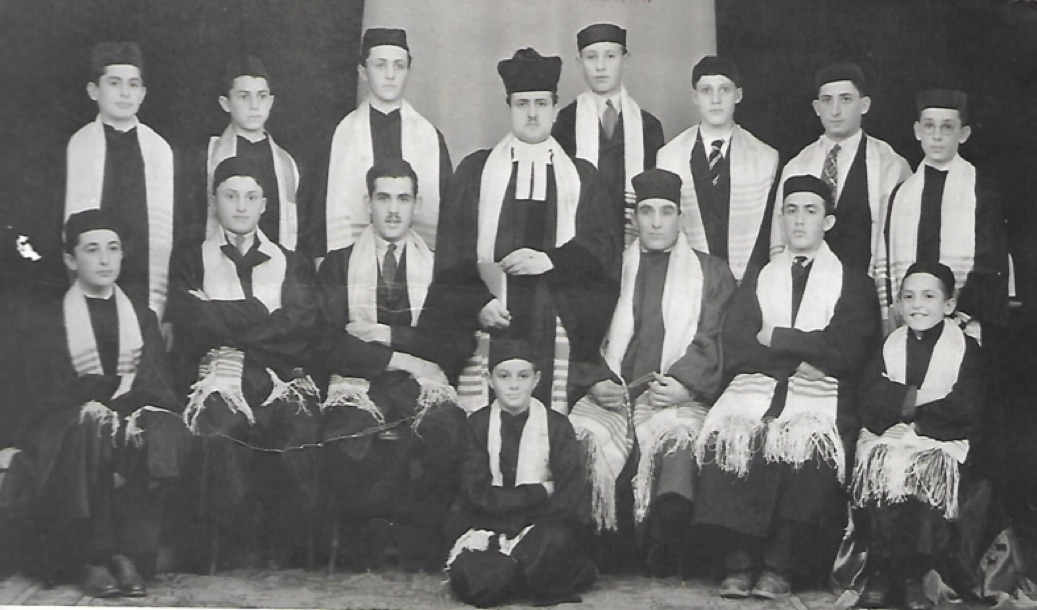
The picture is headed Cantor A Rudy & Choir of the Griqualand West Hebrew Congregation 1930-1932 and the choristers are:
Back Row: Lionel Apter, S Klein, A Goldberg, I Levin, G Fine, M Lazarus, H Mehl
Front Row: Issie Goldberg (soloist), Harry Klein, M Want, Cantor the Rev A Rudy, N Brayton (Choirmaster) M Rudy, M Apter Centre Front: S Maresky
1927-1935Reverend Maurice Konvisser (sometimes spelled with one ‘s’) succeeded Rev Harris Isaacs in 1927. He officiated to the Kimberley community for eight years up to 1935 when he was called to lead the Salisbury Hebrew Community in Southern Rhodesia (at the time). Rev Konvisser became a full-blown Rabbi for Salisbury and subsequently Chief Rabbi of Rhodesia and was awarded an OBE. (Apparently, Rhodes had once said ‘if the Jews come, my country will be alright!’) Konvisser is pictured below, third from left in canonicals. You can read more about him in Kimberley here Rev Maurice Konvisser where there are also excerpts regarding Kimberley committees and people who served on them from the pages from the South African Jewish yearbook of 1929 It shows that the community had several committees and that Rev Konvisser was active in them all. It’s wonderful to have the names of all the committees and their members in 1929. Click the link above to see them. On his retirement from Rhodesia he served in Cape Town until his death.
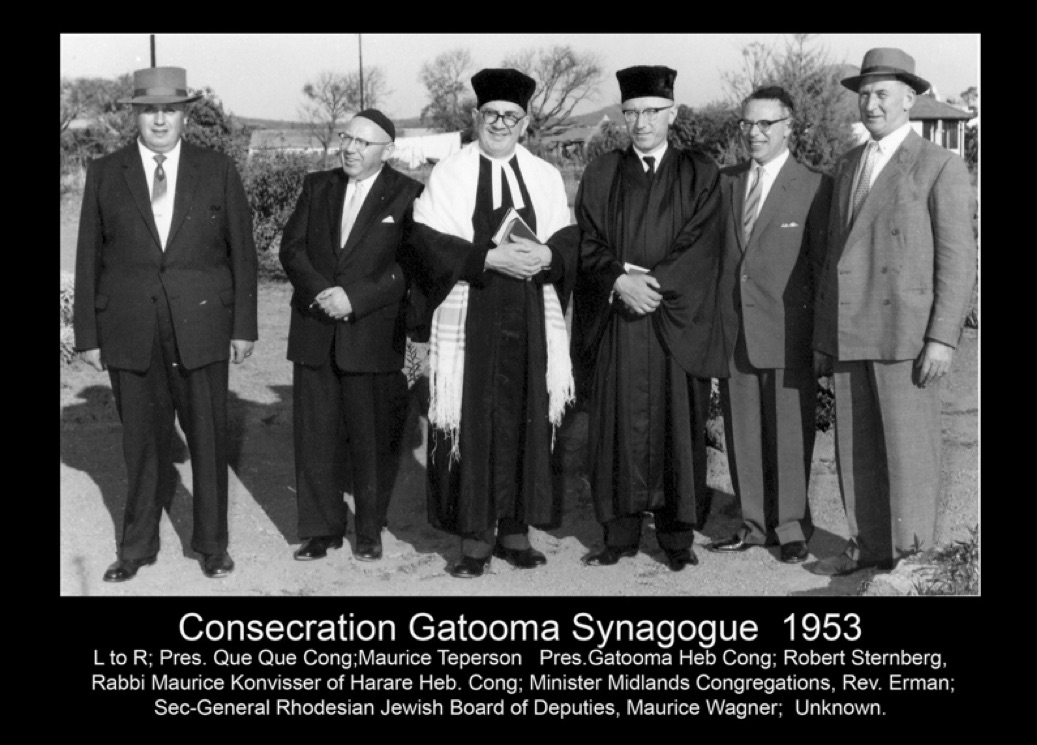
1935-1938 Rabbi Dr Wald
????Rev Israel Segal Died 1945 buried in Kimberley cemetery. (No mention of him to be found).
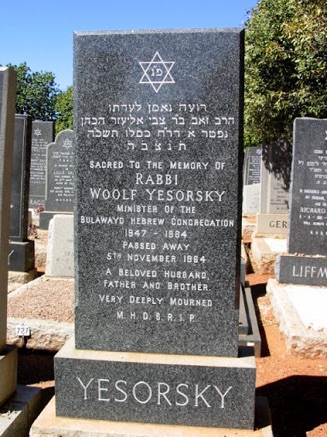
1939-1945 Rev Woolf Yesorsky. As it was wartime, Rev Yesorsky enlisted in 1941 and served as Chaplain to the 2nd South African division in the Middle East until 1943 when he returned to his post until he took a position in Bulawayo in 1945. He was a tolerant and learned man who was much in demand as a lecturer both in English and Hebrew in Bulawayo. Rev Yesorsky and Rabbi Cassel of the Reform Congregtion in Bulawayo got on well together. Rabbi Cassel (born in Frankfurt) never failed to attend the second day of Yamin Tovim in the Orthodox shul. In time Rev Yesorsky got ‘smichah’ and became a rabbi. Among the many dignitaries who attended his induction were all the Christian clergymen of the town. In 1964 it is said that Rabbi Yesorsky committed suicide in a most horrific way. (I have not found out any more about this statement). The community buried him with all the honours due to a spiritual leader – virtually the whole community followed him to his last resting place in Bulawayo.
1941-1943 Rev W Wulf served the congregation in Yesorsky’s absence ‘up north’
1946-1951 Rev A R Abramson During Rev Abramsons tenure, cheder classrooms and a communal hall were added in the grounds of the synagogue. These had been desired for many years. The foundation stone was laid by Dr Israel Brodie Visiting Chief Rabbi of the British Empire in April 1950. Funds were received from A Mrs Helen Siew (of whom I had not heard) and the classrooms were called the Helen Siew Talmud Torah. (a fact I was not aware of). There were opened in November 1950 by Gussie Haberfeld, the President at the time. An Ivrit teacher was employed to augment torah and siddur teaching by Rev Abramson and Rev Bloch, in my time. (1950 – 56). Many dances and socials as well as meetings were held in the communal hall which was a great asset to the community.
1952-1957 Rev C M Bloch (see Gwynn Shrire’s story on her Batmitzvah with Rabbi Bloch Robins (nee Schrire), Gwynn)
1957-1970 Rabbi Oscar Werner and his wife Leah with their three children Sharon, Bernard and Malka served the community for 13 years in its latter heyday when there were many children – including me. He was the one who officiated at my wedding in February 1962. There are stories and tributes to Rabbi Werner on the website here: Werner, Rabbi Oscar, Tributes by Leon Chonin & Bernard Werner he left to be spiritual head of the Greenside community in Johannesburg.
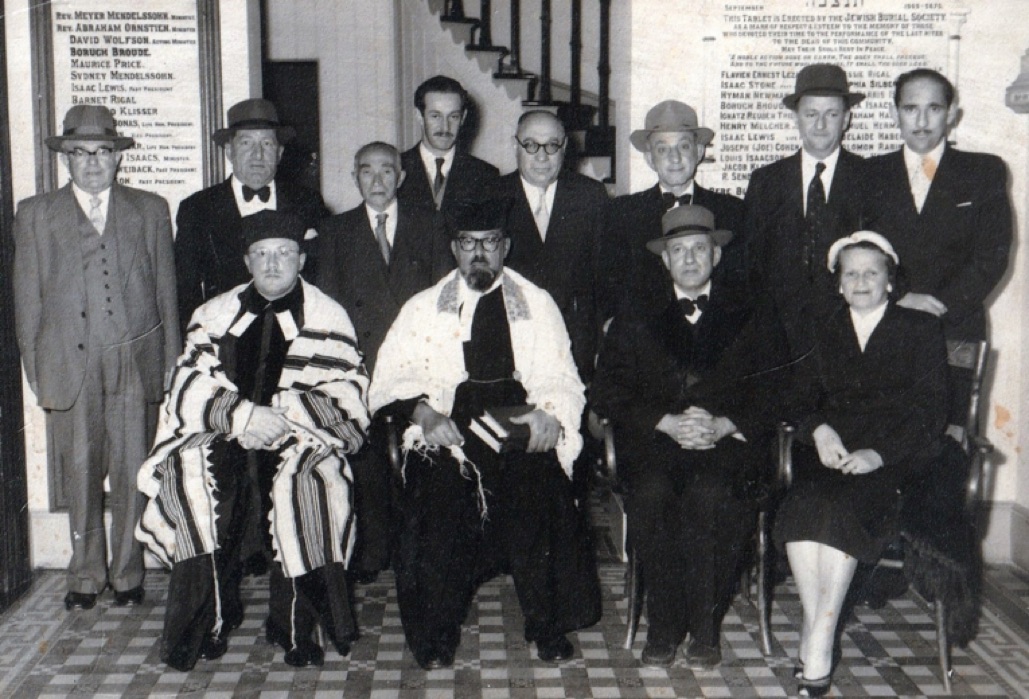
Rabbi Werner’s Induction. Kimberley synagogue 1957
I have just received this picture from David Diamond. He did not remember the occasion or the date or recognise the people in the picture. From postings on the shul Facebook pages and emails we have deduced it was taken at Rabbi Werner’s induction in 1957. From left to right we see David’s father, Beady Diamond, Saul Ginsberg, Jack Maresky, Dr Leon Maresky, the tallest in the back-row middle, and next to him on his right Yankel Pick. Then we see Harry Stein, Aubrey Sacks and Dr Hymie Tockar in the back-row extreme right. In front are Rabbi Oscar Werner and Chief Rabbi Louis Rabinowitz. Then we don’t know who that is – but as Dr Harry Wolfsohn was President of the Congregation at the time (1954 – 61) I am surmising that it is he, next to Hilda Hotz . (Leon Chonin does not think so and surmises it may have been a visitor from Johannesburg). Hilda was for many years, (after Sam Levine) the Synagogue Secretary
1971-1977 Rev Joseph Matzner and his wife Anita were the incumbents after Werner. Barney Horwitz writes: Anita is a niece of the late Solly Alufowitz. They have 3 children, Raoul, Andy and Sidel. They left for Port Elizabeth. The Matzners were much loved by the community. They have continued to attend community events around the country such as the unveiling of Sharon Geller’s Tombstone on 26 April, 2015 and they attended Ida Horwitz wedding in the Kimberley shul in September 2019.
1973 Centenary Celebrations
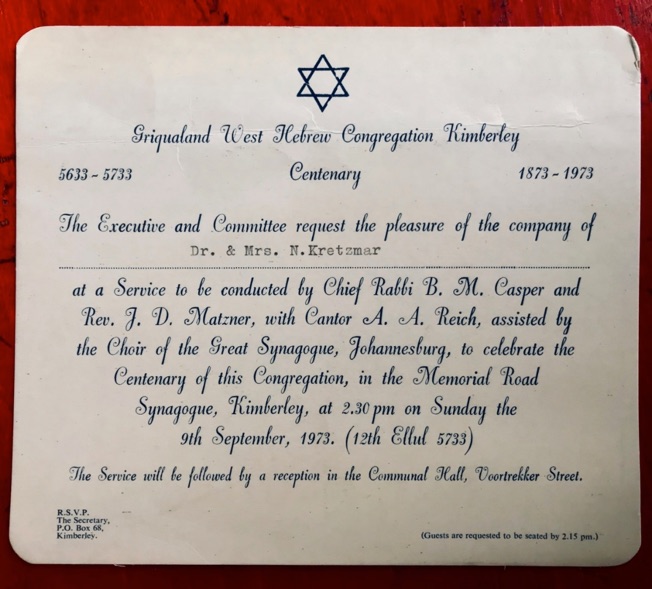
Matzner was in post in 1973, when the community celebrated 100 year since its creation in 1873. There were civic receptions and the Chief Rabbi Casper and the Choir of the great Synagogue in Johannesburg came to Kimberley.
You can read the booklet compiled by Cyril Haberfeld about the occasion and the history of Kimberley Jewry up to that time and also see the souvenir brochure of the service of thanksgiving to commemorate the event, with messages from the congregation president Nathan Cohen and the Chief Rabbi Casper: https://kehilalinks.jewishgen.org/kimberley/Community_files/Haberfeld%201.pdf
Here is the official invitation to members and civic dignitaries that my parents received to attend the centenary service.
Below is a picture of Casper and Matzner at the service of commemoration
In this picture from the DFA of 10 September 1973, the caption reads:
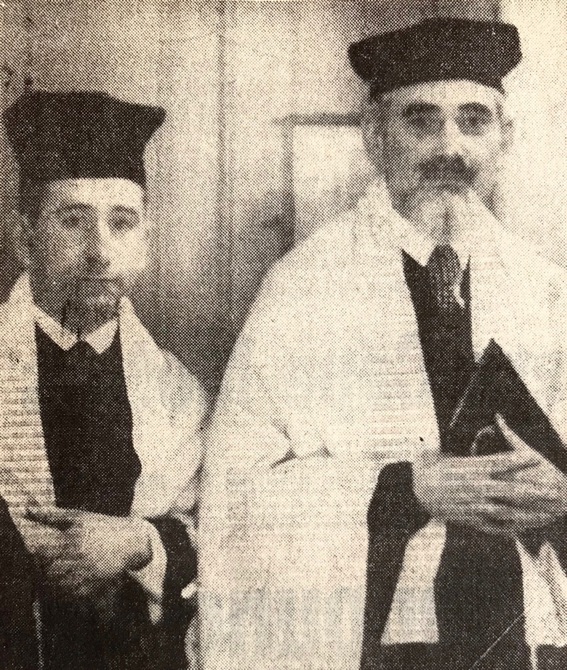
Kimberley’s Jewish Community yesterday celebrated 100 years of religious life in the city with a special centenary service at the Memorial Road synagogue. Among various dignitaries who attended the service were the Mayor and Mayoress of Kimberley, Councillor LHG Shuttleworth and Mrs Shuttelworth and the Anglican Bishop of Kimberley and Kuruman, the Rt Rev Philip Wheeldon. The service was conducted by the Chief Rabbi, the Rev (sic) BM Caspar of Johannesburg, pictured right. With the Rev (sic) Casper is the Rev JD Matzner (DFA)
1977-1981Rev and Mrs Warman came after the Matzners and were there for about four years. They started the Newsletter ‘Don’t be Fariebled’ and then went to Paarl. (If anyone has copies of these Newsletters, please get in touch so we can see how to digitize them.)
1981-1984Rev Copperman and wife Blossom came from Salisbury (Harare) in Zimbabwe (Rhodesia) (makes a change – usually our ministers were going there) and probably had the best voice of all the Ministers we have had. Real Opera class. Also he was a great animal lover who was most famous for responding to a congregant who complained about the presence of Rev Copperman’s dog at the daily minyan by saying “HE COMES TO SHUL MORE OFTEN THAN YOU DO”.
1986-1988 No religious leader June Haberfeld remembers that at about this time there was no religious leader for 2-3 years? when her son Brandon had his barmitzvah although a young Israeli lady, dati, came to stay with them for a few months and she taught the cheder children and went through the parsha with Brandon.
1985-1996 Rev Shmuel and Eunice Kruglak The then Committee, asked him to retire because they estimated the Community would be defunct by the year 2000. How wrong they have been proved to be. He was a great character and radio ham who spoke to the world on his radio rig as much as he spoke to his community.
1997-2000Mendel Nisselow, a law student studying through Unisa served us. An absolutely brilliant young man who went on to score the highest mark in the Northern Provinces board exams for admission as an attorney in 2003 in Johannesburg only to die in tragic circumstances the following year at the age of 27.
Before we get to the 21st century we need to recognise some very important 20th century people who supported the community so magnificently Sam Levine Secretary, Peter Neethling Caretaker and Violet Capon who tended the garden.
1900-1952 Sam Levine Secretary of the community for over 50 years!! Sam came out from England in 1900 to take up the post of Secretary to the Congregation. He served in this post full time until 1935 – and after that for another 17years as part time assistant. Bernard Benjamin remembered that ‘Very often when my mom’s day was done at her college on the Market Square, she would invariably find Sam Levine comfortably waiting in her car for a ride home. In those days, cars were seldom locked…
1940-1960sPeter Neethling The Synagogue Caretaker. Bernard Benjamin says ‘I remember him very well as being a thorough gentleman doing errands for the Shul on his bicycle and always wearing a hat. Milton Jawno also remembers Peter and his wife (her name was Matilda) He says: They both rendered decades of loyal service to our community. They were gentiles. One particular incident that is imprinted on my mind from circa 1950 is of Peter arriving on his bicycle at 48 Milner street, the home of my grandmother Mrs Rose Jawno who was a very pious and saintly woman. He had brought her a lulav and etrog, same having just arrived from the holy land, so that my grandmother could pronounce the blessings, which she duly did at the front door. Thereafter, she returned these items to Peter who mounted his bicycle and rode off.
1950-1970 Vicky Capon says, It is quite true that my mother, Violet Capon did the gardens at the Kimberley Shul. She was very talented with plants and nature and our own garden was beautiful – with fruit trees and grape vines and wonderful flowers! In the shul garden she put in pretty bushes for colour, and saw that the young man working there did the watering regularly. As we lived around the corner from the shul, she was often there to “check up on the gardener.
The Young Doctors
From 2001 Young doctors. After the Millennium, the Kimberley community struck up a good plan. Newly qualified doctors had to spend a couple of years in country districts before they could set up practice in big cities. The Kimberley community would negotiate with some Bnei Akiva type young medics who were passionate about religion and capable of running services and offered them, the ministers house (down the road from the hospital) if they would agree to run services at the weekends. This was a great success.
2001Wayne Nates, Barney Horwitz writes, was our first Community Service doctor who served us in 2001. From a rabbinical family he made an awesome spiritual leader and went on to become a highly respected anaesthetist who currently lives in Toronto, Canada. He married a Canadian girl of South African descent. Best anecdote from his tenure- while doing a short course in Anaesthesia at Free State University he went into the Brandwag Pic ‘n Pay and asked the Deli Attendant if they kept any kosher meat to which she replied “certainly we do” and then proceeded to produce ham!!!!!!!!!!!!!
2002Ryan Karro, a descendant of the great Reb Karro of Sfad in the 1600s was our second Community Service Doctor who served us in 2002. A wonderful, humble young man who endeared himself to the entire community and is still sadly missed by many. Highly competent as a Doctor he ultimately became a surgeon and lives in Cape Town.
2003Craig Gordon was our third community service doctor who served us in 2003. A really amiable soul, Craig not only came to Kimberley for the year but brought his parents with and they stayed on for a few years after he left. Craig emigrated to England and has worked there as a doctor ever since.
2004-2006Rael Codron was our fourth and longest serving Community service doctor. Rael served us from 2004 through to the end of 2006 and then again in 2010. Rael had a vast knowledge of Judaism the equal of many Rabbis and was immensely popular. He went on to work as a ship’s doctor all over the world for many years and about three years back settled in Australia where he works as a specialist emergency medicine practitioner.
The Four Barmitzvahs!
Rael Codron was a great success and his tenure culminated in the four bar mitzvahs in January 2005 This was an amazing event (that I, Geraldine, fortuitously gate-crashed as I just happened to be in Kimberley that weekend with my family, not knowing anything about it in advance). As we passed the shul on Friday night the lights were on and windows open and full-throated song was emanating. I could not believe it. We rushed in only to be warmly greeted by those who still remembered me, and told they were having 4 Barmitzvahs that weekend! Really? I was sure there were no children left in Kimberley. It turned out it was the doctors’ idea of Rael Codron and Rael Salkinder.
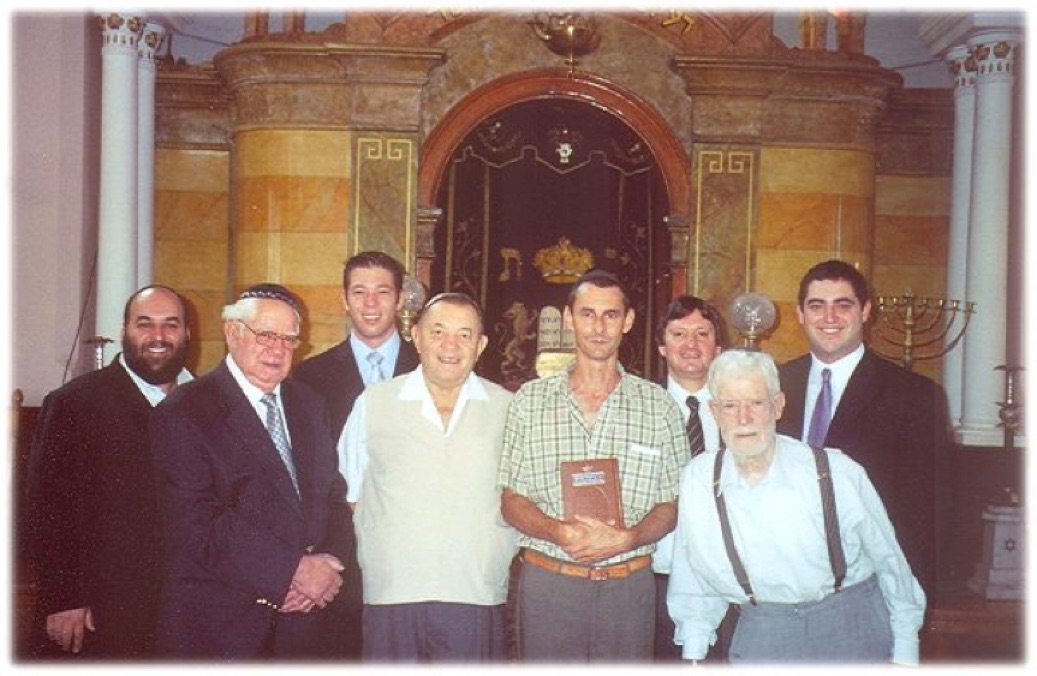
The FOUR Barmitzvahs in January 2005. this picture was taken after the quadruple barmitzvah celebration in Kimberley. From left: Rabbi Moshe Silberhaft, Leon Cohen, Rael Salkinder, Jules Katz, Anthony Rabie, Barney Horwitz, Goldie Mehl and Rael Codron
The celebrants were Jules Katz and Goldie Mehl the President, both 83 and celebrating their second barmitzvahs, Leon Cohen who had missed out on his barmitzvah through illness and Anthony Rabie who, living in the country, had never had the opportunity. What a happy occasion it was. We were invited to join them for supper in the communal hall where I had enjoyed so many communal functions in my youth and childhood, Yom Kippur dances and pageants. I was able to make a little speech and brought greetings from London to the barmitzvah boys. The congregation was made up of the children and grandchildren of the celebrants, a well as the parents and grandparents of the young doctor/rabbis. As we see in the picture below Rabbi Silberhaft was there as well. Read about that amazing event here: https://www.africanjewishcongress.com/ncrsa2.htm
Barney Horwitz writes in April 2020: Over the last twenty years we have had several groups of young doctors who have spent some time in the city and while not our spiritual leaders they have contributed greatly to the community. Some of the other names that come to mind are Myron Scopp, Bradley Rabin and Rael Salkinder. Following Rael Codron’s second departure in 2010 we ran out of Community Service Doctors basically as a result of emigration and since then Barry Katz and I (Barney Horwitz) have led the services over shabbat. And on every Rosh Hashanah Nachi Ash and Josef Shissler run our services.
Rabbi Moshe Silberhaft
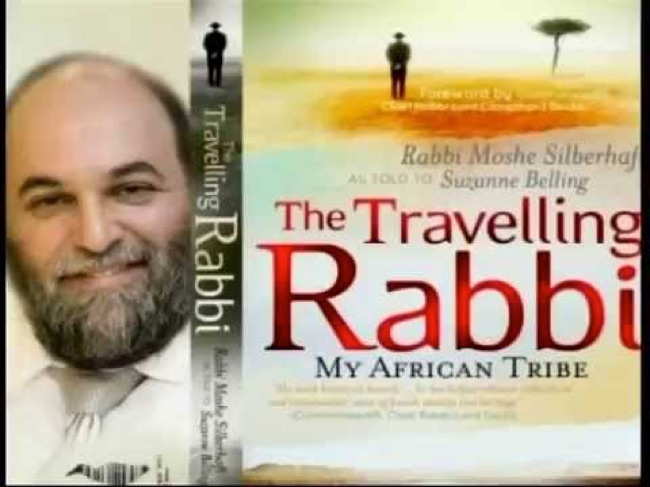
Rabbi Moshe Silberhaft as the Country Communities Rabbi, is in fact our Official Rabbi. Barney Horwitz says: He has been so since around 1994 when he was first appointed. Rabbi Silberhaft is our first port of call when an officiant is required for any life cycle event such as a bris, barmitzvah, wedding or funeral or any halachic question needs to be answered. He is a great friend of our community and was the man who found us Nachi Ash and Josef Shissler and his son Yossie who now lives in Israel also used to come to us over the High Holy days when he was in High School in South Africa. Recently he was appointed as the National Director of the Small Jewish Communities Association of South Africa, of which I am the first Chairman. We look forward to a long and mutually rewarding relationship with Rav Silberhaft.
Yeshiva Bochers for the High Holydays
From 2001Yeshiva Bochers. Since 2001 the community has benefitted from the services of Nachi Ash and Yosef Shissler who first came down to run the High Holiday services in 2001. This has been a real metziah!. Chairman Barney Horwitz writes: ‘Nachi and Josef and their wives have been coming every year since 2001. Both come from Rabbinical families and in day to day life Nachi is an Accountant and Josef a family law specialist attorney. Their dedication to keeping our High Holy days services going is unique. Every year they come with their wives, children and around five other families and another five single men. Their services are superb and run like clockwork. On Yom Kippur we always get to the break by 1.30 pm which is remarkable and their harmonies and the spirit they engender in the shul with their humour is something to experience. Very few Shuls in South Africa are as warm and happy as ours at this time of the year. Recently we had visitors from big congregations in the US and Israel who shared in our Shabbat service they took before the recent wedding of my daughter Ida and Zach, and all our guests commented on the wonderful spirit they generate. They create a wonderful chassidishe atmosphere such as Kimberley probably never experienced in its more serious hey-day.
2012: The 110th Anniversary of the Memorial Road Synagogue
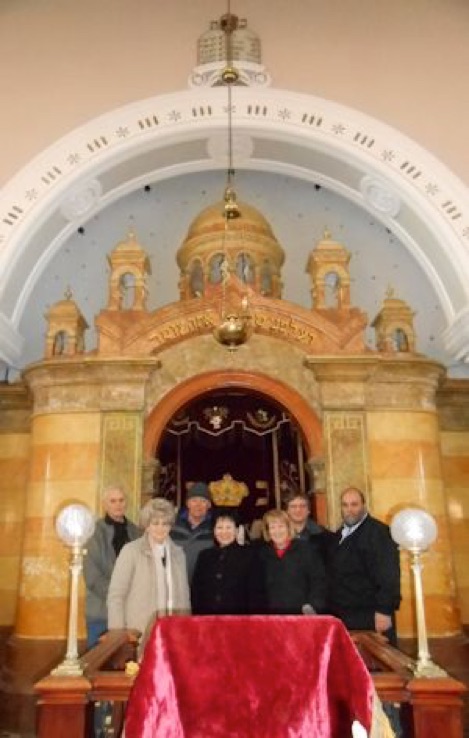
The commemorative programme was organized under the combined auspices of the African Jewish Congress (AJC), the South African Jewish Board of Deputies and the Griqualand West Hebrew Congregation. It was the brainchild of AJC President Mervyn Smith. It kicked off with a Maariv service in the synagogue, with Spiritual Leader Rabbi Moshe Silberhaft officiating. Afterwards, participants were joined by some forty members of the local community at the William Humphrey Art Gallery, where a special exhibition of works by Jewish artists in the gallery’s collection were on display. The latter included over seventy works by, amongst others, such renowned artists as Irma Stern, Lippy Lipschitz and Moses Kotler.
In the picture left at that momentous event are l-r
MERVYN SMITH – ANN HARRIS – ARNOLD RAUFF – LI BOISKIN – IRENE ZUCKERMAN – BARNEY HORWITZ – RABBI MOSHE SILBEERHAFT
Community leaders Barney Horwitz and David Allen spoke on the history of the congregation, from the first settler onwards. Chevra Kadisha chairman Arnold Rauff entertained the audience with an amusing series of anecdotes and vignettes relating to Jewish life in the area. The next day was devoted to visiting sites of local historical interest, including a guided tour of the Magersfontein battlefield and a “virtual mining experience” the Kimberley Mining Museum and Big Hole.
Chaim Ehrich led the Shabbat evening services, which were followed by a communal dinner in the communal hall. Speakers included AJC President Mervyn Smith, SAJBD Cape Region Chairwoman Li Boiskin, Former Chief Rebbetzin Ann Harris, and the chairwoman of the African Region for the International Council of Jewish Women, Irene Zuckerman. A common theme that emerged from the ensuing comments from the floor was how, in a small community, every individual counted to a much greater extent than was the case in places like Johannesburg, where one could easily become just a statistic.
Ann Harris paid tribute: “While it is sad that a community of such stature, one of the first bastions of Jewish life in South Africa, has suffered an inevitable decline in numbers, all who took part were delighted to be able to support and salute those who still keep the shul alive and to marvel at their optimism, their resilience and their loyalty to our traditions”.
There was a joyous atmosphere at all the Shabbat services, with full Shabbat morning services including the Torah reading being held in the shul for the first time in years. Currently, the congregation holds services on Shabbat, the High Holidays, and special occasions.
On Saturday night, Trevor and Hubre Datnow hosted over sixty participants for a braai at his farm.
The weekend’s activities concluded with visits to the city’s two Jewish cemeteries, where Rabbi Silberhaft intoned hazkarot, and a communal brunch in the shul hall. You can see the SABC Simcha programme coverage of this event here http://www.youtube.com/watch?v=labuYuh4bRs
EX-Pats Supporting the Community
Maybe this is an appropriate time and space to mention that you as an ex-pat you might like to support the efforts to maintain the community and its work and its buildings.
As Leon Chonin put it:
‘I am sure you are all aware though that with the declining Jewish population in South Africa, the Board of Deputies who previously supported the smaller communities has been struggling to provide the necessary financial backing to these. Barney is now himself Chairman of the new group tasked to take this role and specially to support the services of Rabbi Silberhaft to continue with his mission to serve small communities.
‘The very small community now left in Kimberley still needs to maintain the facilities that once had the support of nearly 200 Jewish families. The most important concern is to maintain and protect the Jewish cemeteries where our loved ones now rest in peace. They at least, deserve our support to ensure that the grounds are secure and that the tombstones are not damaged.
‘We want to appeal to all our ex-Pats to consider making an annual – or even a one-off donation on Yom Kippur – or at any time – to the Kimberley community for the support of their community and its charitable aims. You can make your donation by cheque or bank transfer as below or speak to Barney about how you can help. (Address and bank details below)
Please make your donation – now and often as below.
Barney Horwitz
GW HEBREW CONGREGATION
PRESIDENT : D. ALLEN ; CHAIRMAN : A.B.HORWITZ
Ground Floor, Barnet House, 45 Dutoitspan Road, (P.O. Box 1601) Kimberley, 8301 (8300)
Tel : 053-8311051, Cell: 082-3316266, Fax: 053-8323632 E-mail: ahorwitz@lantic.net
The bank details of the Congregation are as follows:
Bank: Standard Bank
Branch: Kimberley
Branch Code: 050002
Swift Code: SBZAZAJJ
Account Name: Griqualand West Hebrew Congregation
Account Number: 04-005-444-6
Compiled by Geraldine Auerbach MBE London, April 2020
Compiled by geraldine.auerbach@gmail.com
This website is managed by Eli Rabinowitz
Updated June 2020
Copyright © 2020 Eli Rabinowitz


